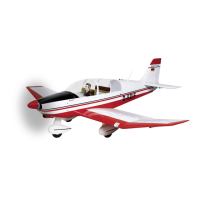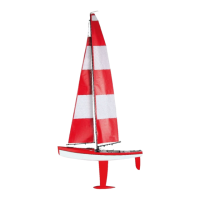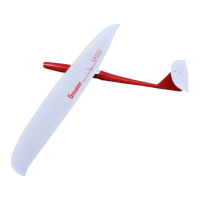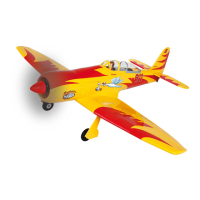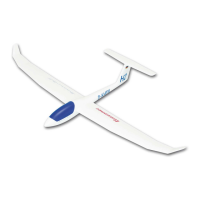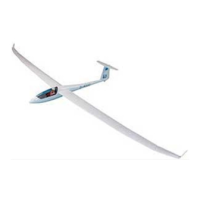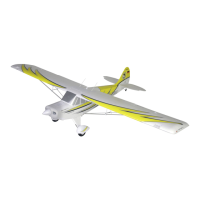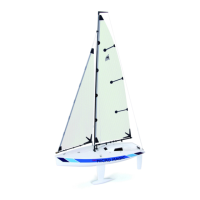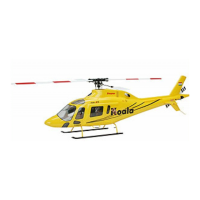GRAUPNER GmbH & Co. KG D-73230 KIRCHHEIM/TECK GERMANY
Keine Haftung für Druckfehler. Technische Änderungen vorbehalten! ID# 47496 10/2003
22
Now cut out the following ABS parts: the cockpit (part 57), the bottom cockpit section (part 58), the
companionway (part 59), the skipper’s seat (part 60) and the two parts of the upper bench seat (parts 61 +
62). Work carefully when cutting; it is best to trim the mouldings gradually to obtain a snug fit. We suggest
that you cut out the parts slightly oversize initially, then sand back the material gradually until all the parts
fit together. The laser-engraved joint lines on the bridge deck act as a useful guide for positioning these
parts. TIP: ensure that the support surface of the bench seats follows the camber of the deck. TIP 2: if you
find that the joint area of the vacuum-moulded parts tends to distort, cut small stiffening plates from 4 mm
thick scrap wood and glue them in the bottom of the mouldings. This also provides a larger gluing area
when fixing the parts in place.
Repeat the procedure outlined above with the lower bench seat (parts 63 + 64 + 65). Cut the back panel
(part 66) for the lower bench seat from scrap ABS; it only needs to cover the exposed area which projects
above the side cladding. When you are satisfied that all the parts fit together well, glue them together and
paint them. Repeat this process with the section of the superstructure which is not covered by the roof.
TIP: we recommend that you apply the decals to the cockpit section before installing this in the model. The
cockpit fittings are best fitted at a later stage, as they can easily be broken off during subsequent work
otherwise.
Assemble the upper table (parts 67 + 68 + 69 + 71 + 73) and the lower table (parts 67 + 68 + 70 + 72 +
74). Before you glue the two table tops in place you should paint the components and stain and lacquer
the wooden parts. The completed tables can then be glued to the model.
Make up the handrail (part 75) for the rear bridge panel from the flexible beech strip. After staining and
lacquering the rail glue it centrally to the rear bridge panel using thick cyano. Take care that no cyano runs
onto the back panel.
Trim the outer window frames (part 76 + 77 + 78) and the inner cladding panels (parts 76 + 79 + 80) for
the roof, as already described for the superstructure. Check that the frames on both sides of the glazed
areas line up accurately, as offset frames look untidy.
Cut the ventilator flaps (part 81) from scrap ABS and glue them to the window frames. Drill a series of 1.5
mm Ø holes in the window frames for the windscreen wipers. Don’t install the wipers at this stage; they
are fitted later.
Carefully sand the top edge of the window frames absolutely flat, and cut the trim rails (parts 82 + 83 + 84
+ 85 + 86) to shape as shown. Paint the rails and glue them carefully to the frames using thick cyano.
Ensure that no cyano runs onto the wooden parts. TIP: the rails will be easier to glue in place if you pre-
curve them first.
Cut a door template from scrap ABS or wood to enable you to mark the position of the two doors using a
soft pencil.
The roof can now be glued to the superstructure. Check that the roof makes good contact with the
superstructure all round, without requiring pressure; trim the moulding if necessary. This applies in
particular to the area of the bench seats and the companionways.
Cut the two handrails (parts 87 + 88) from the flexible beech strip. Finish the handrails as described for the
rear bridge panel handrail, and glue these to the side cladding panels. Cut a notch in each handrail at the
marked door positions; without the notch it would not be possible to open the doors. Note that the
handrails should project outward slightly, i.e. they should not be fitted centrally.
The stern handrail is made up from the handrail stanchions (part 89) and the handrail (part 90), which
consists of 2 mm Ø ABS round rod. First mark the two holes in the side panels; the other holes are
marked on the superstructure. Drill 2 mm Ø holes at the marked points and push the handrail stanchions
in the holes (don’t glue them yet). Thread the handrail through the first stanchion, then pull it through all
the remaining stanchions. The plastic handrail will take up the correct shape automatically. Glue the
handrail to the stanchions, but not to the superstructure. Remove the handrail assembly and shorten the
ends of the rail. Paint it stainless steel colour, then plug it into the superstructure again and glue the
assembly in place. Cut off excess stanchion material on the inside, otherwise the superstructure will not
rest properly on the deck.
The next step is to assemble the derrick (crane) from the following parts: base (part 91), external outrigger
(part 92), internal outrigger (part 93), tongue (part 94), turnbuckle (part 95) and split pin (part 96). Cut out
the vacuum-moulded parts and glue the internal outrigger into the external outrigger. Note that a piece
about 5 mm long should project out of one end. Glue the outrigger to the base. Straighten the ends of the
tongue and attach it to one end of the turnbuckle using the split pin. Place the other end in the recess in
the derrick base and glue the tongue to the outrigger. Now glue the other end to the base. Paint the
derrick black overall except for the turnbuckle. This is intended to represent a hydraulic cylinder, so the
threaded part should be painted silver.
Cut the two shells of the inflatable boat - bottom section (part 97) and top section (part 98) - to
approximate size, leaving a gluing flange at least 5 mm wide. Glue the two shells together, allow the glue
